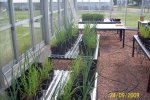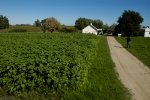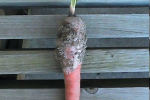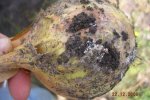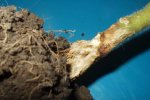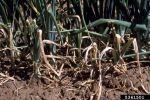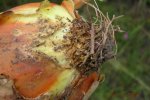Crop rotation design in view of soilborne pathogen dynamics
During the last decades, agriculture went through an intensification process associated with an increased use of fossil fuel energy, which despite temporarily increasing yields often resulted in decreased overall sustainability. Crop rotation is considered a cornerstone of sustainable farming systems. The design of crop rotations is a complex process where several objectives should be combined. Models can support the design of crop sequences and help to reveal synergies and trade-offs among objectives. Despite their importance, pathogen dynamics are rarely taken into account in cropping system models, not in the least because quantitative information from classical crop rotation experiments to calibrate and evaluate the models is resource demanding, and therefore scarce.
The aim of this thesis was to develop a research approach where data (greenhouse pot experiments, microplot experiments, surveys on commercial farm fields) and model simulations were combined to identify crop sequences that minimize soilborne pathogen inoculum build up, and to subsequently include this information into models for designing sustainable crop rotations. The study was carried out based on two ecologically distinct and relevant pathogens in vegetable production systems: Sclerotium rolfsii and Fusarium oxysporum f.sp. cepae (Foc).
figure 1- 3 Experiments at three different levels, from plastic pots in the greenhouse to full-size experiments on commercial farms. Click on the pictures for more information or to scroll through the pictures .
Two aspects of the dynamics of S. rolfsii sclerotia were studied: survival after soil incorporation of green manures, and population changes under three cropping sequences. In pot experiments, sclerotia survival in soil after incorporation of a winter green manure and its decomposition during summer was generally lower than after summer green manure incorporation and decomposition during winter. The incorporation of various legume crops (black beans, cowpea, hairy vetch and lupines) allowed multiplication of sclerotia while various grasses (sudangrass, foxtail millet, oats and wheat) as well as sunhemp resulted in a reduction of sclerotia in the soil. The build-up of sclerotia populations in the microplots was dependent on the crop sequence. Multiplication in sweet pepper was greater after black oat than after onion or fallow.
figure 4-6 Sclerotium rolfsii can affect a wide range of crops, with onion, tomato and carrot as shown here being only 3 of the more than 500 known species acting as a host for this fungus. It attacks primary the stems of its hosts, but can spread also in other parts like roots and leaves. Click on the pictures for more information or to scroll through the pictures .
The dynamics of Foc was studied at two different levels: multiplication in individual plants and population changes in different crop sequences. Foc colonized and multiplied in the root systems of 13 non-Allium plant species without inducing disease symptoms or growth retardation. These species thus constituted “reservoir-hosts” for Foc. The lowest Foc levels per g of dry weight of root were found in wheat, sunflower, cowpea and millet whereas the highest Foc level was found in black bean. Fusarium pathogen dynamics was strongly affected by the cropping history in a particular field. Fusarium populations increased from transplant to harvest of onion when another onion crop had been planted in the same field during the previous winter, whereas Fusarium populations decreased when a winter green manure had been planted.figure 7-9 Fusarium Basal Rot affects the roots and bulb of onions, causing production losses during the growing season and after harvest. Click on the pictures for more information or to scroll through the pictures .
Pathogen dynamics in crop sequences was simulated by concatenating two simple models, the first one describing the build-up of the pathogen within a crop, and the second one describing the dynamic of the pathogen during the intercrop period. The simulations described differences among crop sequences and alternating cycles of increasing and decreasing soil pathogen populations, as well as differences at equilibrium populations related to host frequency and cropping history. This thesis provides a methodological approach to the design of crop rotations and their effects on soil borne pathogen dynamics. The combination of data from controlled experiments, novel analytical tools (Bayesian analysis, modelling and simulation) and on-farm observations can lead to the identification of optimal crop rotations without extensive field experiments that require a lot of time, space and economic resources.
